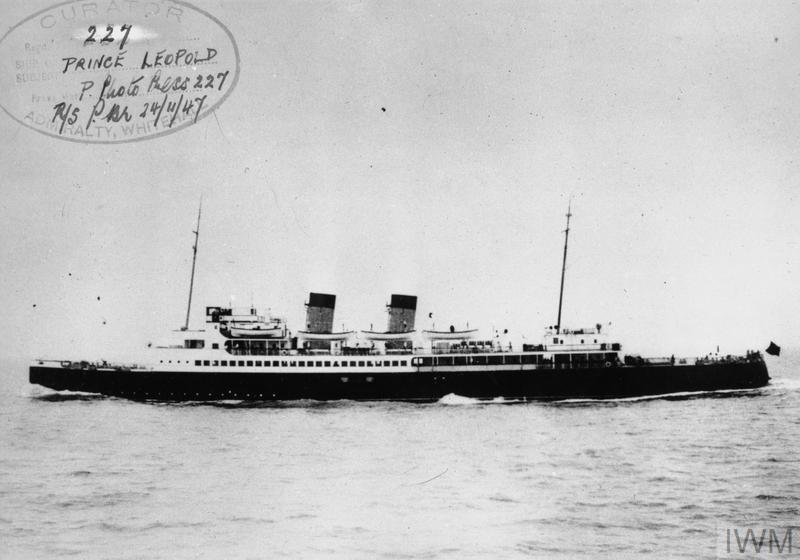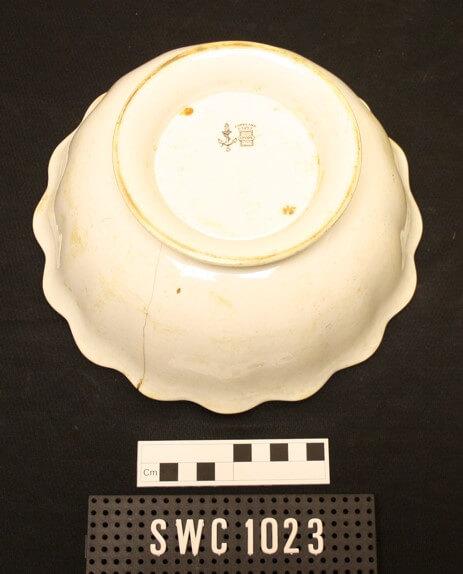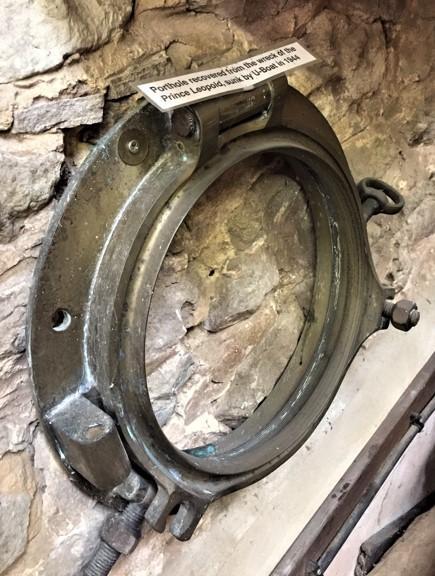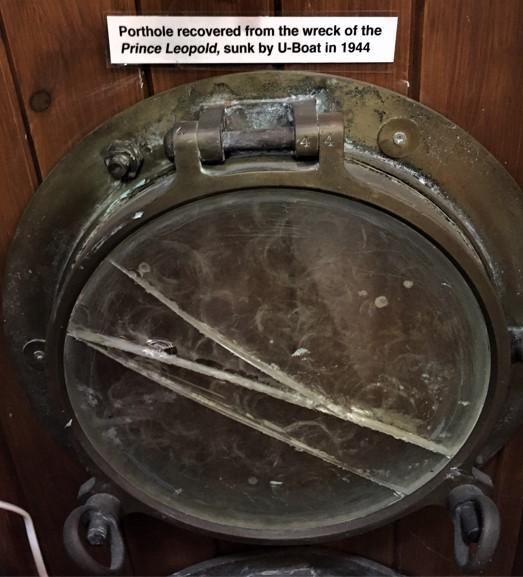The fascinating story of HMS Prince Leopold includes its service as a cross Channel ferry, an Admiralty air target craft or hospital ship, and as one of the landing craft Infantry ships for D-Day. MAT volunteer Roger Burns explores Prince Leopold’s history in depth, including information on artefacts from its wreck site, which are on display at the Shipwreck Centre & Maritime Museum.

TS Prince Leopold was launched in November 1929 by John Cockerill SA. Based in Hoboken, Belgium, its steel hull measured 105.8m long, with 14.1m beam and 2,938grt. It was fully completed in mid-July 1930 for the Regie voor Maritiem Transport, Oostende, Belgium, as a ferry with capacity for 1,400 passengers. Equipped with 6 x steam turbines SR geared to dual shafts and 6 x water tube boilers, it was capable of 23.5 knots. On 14 July 1930, a fire in the engine room delayed its delivery until 30 July. Three days later, Prince Leopold began its career as a ferry on the Dover-Oostende service. It continued in this role with few interruptions until the Dover destination changed to Folkestone in December 1939. This was short lived as, when Germany invaded Belgium, Prince Leopold sailed to Southampton to be converted into a hospital ship, although this change never went ahead. Some sources also indicate that it was intended to be used as an air-target ship.
A Notable Event in Prince Leopold’s Career
Backtracking to 1930, the Daily Herald of 8 October carried a long and poignant article about the return from Boulogne to Dover of the coffins of 47 casualties from the Airship R101 disaster aboard HMS Tempest. Included in the article was a short paragraph: “Silently the ship hove to. Cranes felt their way towards the decks. Gently, tenderly, the coffins were lifted, two by two, into the storm-swathed sky, and lowered onto the shoulders of the Air Force men. Soldiers, sailors, airmen, and City dignitaries moved froward through the gale with their tributes. Then came six stalwart sailors of the Belgian passenger ship, Prince Leopold, with the tribute they had bought out of their own earnings, fidgeting with hats as they bowed to the dead heroes. Followed their officers, with the wreaths they had bought at the cabled orders of the Belgian Government”.
Prince Leopold in WW2
The Courier and Advertiser of 21 May 1940 carried a long article about the ordeal of a British golf professional from Tayport who was based at the Royal Zoute Golf Club in Belgium, and with the Germans invading was attempting to get home – he relates the destruction by German war planes of buildings adjacent to the hotel he was waiting in, with several hundred others at nearby hotels who had been advised to wait there in Oostend prior to boarding the Prince Leopold. Apparently, the planes had been targeting the Prince Leopold but had missed, instead hitting buildings adjacent to where he was waiting. Those who were already on-board Prince Leopold disembarked and all managed to return on a crowded troopship.
Prince Leopold assisted in the June 1940 evacuation of St. Malo, Cherbourg and Brest. On 23 September 1940, Prince Leopold was requisitioned by the Admiralty and sent to Devonport, where conversion to a Landing Ship infantry (Small) – LSI (S) – was completed by 6 March 1941, and allocated pennant 4251. Now equipped to carry 8 LCA’s/LCS(M)’s or LCP(L)’s1 and 250 troops, it was armed with 2x12pdr AA (2×1), 2x2pdr AA (2×1), and 6x20mm AA (6×1) guns. HMS Prince Leopold took part in Operation Archery in December 1941, then Operation Jubilee in August 1942. It landed troops in Sicily in July 1943, and on Sword Beach, Normandy, in June 1944. The Historical Military Records website “Fold3” (accessible via Ancestry or subscription) contains an American detailed report for 7 June 1944 of the Normandy landings involving Prince Leopold, which had sailed in convoy from Portland. One of the documents included the statement: “The H.M.S. Prince Leopold performed very satisfactorily the duties assigned her as transport in Assault Group C-4”. It also praised the skill of the LCA’s in avoiding underwater obstacles, successfully landing the troops, and then withdrawing from the beach. (“Fold3” at https://www.fold3.com/browse/251/hsEUS91acJRDDkBHFW-cVa9z3u7o_Tppk).
These operations resulted in a number of awards, including:
- “For distinguished services in HMS Prince Leopold in the successful landing operations in Sicily, the Messina Straits, Salerno and Normandy: – DISTINGUISHED SERVICE CROSS – Temporary-Lieut. Herbert Antony Carter, R.N.V.R. (Poole)”, as reported in the Western Gazette of 1 September 1944.
- “For distinguished services in HMS Prince Leopold in the successful landing operations in Sicily, the Messina Straits, Salerno and Normandy: – Mention in Despatches – Signalman R.N. Quinn (Walsall)”, as reported in the Birmingham Daily Gazette of 30 August 1944.
- The Birmingham Daily Gazette of 15 February 1945 carried this article:
“THE KING KNEW Worcester Man at Investiture
Lieut-Comdr J.M.F. Cassidy, R.N.V.R. of The Cedars, Kempsey (Worcs.), who commanded a flotilla of landing craft at Salerno and later at the Normandy beach-head, received the D.S.C. and Bar from the King at a recent investiture. His ship, the Prince Leopold, was one of the first to take part in combined operations, and was commanded by Louis Mountbatten, then Chief of Combined Operations.
‘Jolly good show – I know quite a lot about it’ said the King in shaking hands with Cassidy, who was accompanied in the Palace by his mother, Mrs. M.E. Cassidy, and a friend, Miss E. Bradley”
- Another three awards, not accessible online, were made when Prince Leopold was sunk.
An interesting French five-franc invasion currency banknote is on display at the D-Day Story Collection in Portsmouth. The banknote was “signed by members of 5th US Rangers shortly before they landed on Omaha Beach. It was given as a memento to W.H. Mason, a bosun on board H.M.S. Prince Leopold. 1st Lieutenant Dee C. Anderson, whose signature appears on the right, was killed on D-Day. This unit landed on the main beach on D-Day (while 2nd Rangers assaulted Pointe du Hoc). The Prince Leopold carried LCA (Landing Craft, Assault) of 504th LCA Flotilla, craft numbers 550, 568, 570, 571, 622, 623 and 1045. It is not known which LCA W.H. Mason served on”.
After D-Day, Prince Leopold continued to cross the Channel with more troops until 29 July 1944 when it was disabled by an acoustic homing GNAT torpedo fired from the German submarine U-621. Prince Leopold was listing badly, so HMS Chelmer, which had come alongside to lend help with its pumps had to let go, and the Prince Leopold was taken under tow by the tug Amsterdam, but capsized and sank before reaching safety. The numbers on board were uncertain but at least over 200, of which 54 are known to have died.
The Wreck Site
Efforts were made to disperse parts of the wreck of the Prince Leopold in 1944 and 1945, with wire sweeping to reduce the height of the remains and prevent potential hazards to shipping. Diving activity on 26 October 1976 located the wreck at a general depth of 30 metres on a sand and gravel seabed, approximately 6 miles south of the Nab Tower, off the Isle of Wight. In 1981, the highest point was reported to be the Bofors gun, 10m above the general depth of 30m, with three cases of ammunition near the gun. The stern was intact and the hull lay with a 30-degree list to starboard. The bow was intact lying with 65-degree list to starboard and none of the superstructure stood above the hull. By 2007, some of the metal was deteriorating quickly.
Several artefacts were recovered. The Ship’s Bell is now in Oostend’s Historisch Museum De Plate. A fluted bowl (Figure 2) and two portholes (Figures 3 and 4) are on display at our museum.



If you would like to see some of Prince Leopold’s recovered artefacts for yourself, why not come and pay us a visit? Find out more and book your ticket.
